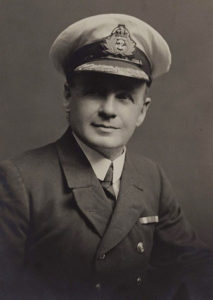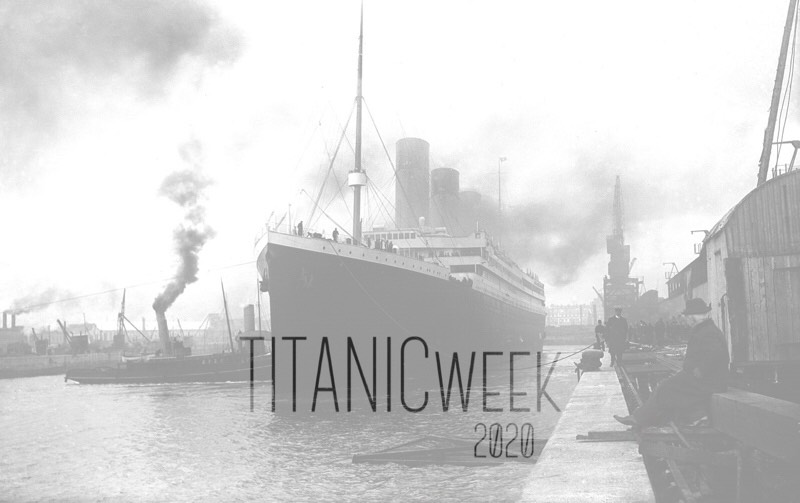"Titanic Behaved Splendidly": Titanic's Sea Trials
Titanic’s sea trials—when the ship’s many safety features were tested in real time—were scheduled to begin on Sunday, April 1, 1912, but poor weather conditions and a detrimental northwesterly wind caused the trials to be postponed to Monday morning.
Aboard were just over 40 crewmembers. They were compensated an extra five shillings for the delay.

Captain Edward J. Smith.
The roster of officers reporting to Captain Smith for sea trials were as follows.
Chief Officer William McMaster Murdoch
First Officer Charles Herbert Lightoller
Second Officer David Blair
Third Officer Herbert John Pitman
Fourth Officer Joseph Groves Boxhall
Fifth Officer Harold Godfrey Lowe
Sixth Officer James Pell Moody
The four junior officers received telegrams from the White Star marine superintendent to report to the Liverpool offices at 9am on March 26th, to pick up their trains tickets for their trip to Belfast.
They arrived around noon the next day on March 27th and reported on board to Chief Officer Murdoch. Notably, in his deposition later, Fifth Officer Harold Lowe attested to a March 29th arrival.
Fifth Officer Lowe and Sixth Officer Moody were instructed to inspect the totality of starboard-side lifeboats, including the collapsibles. Together, they conducted an inventory of life-saving materials such as oars, sail riggings, and tarp; he also recalled that he noted one empty "bread tank" in each of the lifeboats but none in the collapsible boats, nor emergency lanterns in any of the boats at all.
Captain Edward J. Smith boarded on April 1st, and with him came an officer arrangement that upended the ship's commanding hierarchy. At the last minute, he announced his intention to bring on Henry Tingle Wilde as Chief Officer.
So William Murdoch and Charles Lightoller were both demoted to First and Second Officers, respectively.David Blair was dismissed from command altogether, which safeguarded the remaining junior officers from a reshuffle themselves.

Titanic Chief Officer Henry Tingle Wilde in Royal Naval dress.
When Former-Second Officer Blair disembarked in Southampton, he disembarked with his keys... including the key to the locker for the Crow’s Nest. This secure cabinet is where implements were housed for the lookouts.
Including binoculars.
George Hogg, a surviving lookout on Titanic, testified to the Senate regarding David Blair's actions as he was set to depart at Southampton, having been dismissed from his duties.
Mr. Blair was in the crow's-nest and gave me his glasses, and told me to lock them up in his cabin and to return him the keys... I locked [the binoculars] up... There were none when we left Southampton.
It is sometimes implied that Blair did this nefariously as some Shakespearean act of revenge due to his dismissal, but in reality, it was industry practice to lock up the binoculars when a ship was docked.
Other accounts state that David Blair took the binoculars with him because they were his own personal pair.
Regardless, Now-Second Officer Lightoller could not provide the lookouts with binoculars. He didn’t think too much of it, as there were other glasses on board somewhere and the lookouts could spot without them, being at such a height as the lookouts were, so he promised to pick up a new pair in New York City.
And that was that.

Charles H. Lightoller, who was demoted to Second Officer on Titanic.
Titanic was the second sibling in a set of triplets; her elder sister, Olympic, underwent her sea trials beginning on May 29, 1911, and ran for two days. They were not without difficulties.
According to Tom McCluskie, a historian for Harland & Wolff, “The extensive sea trials found that there was a number of problems. Chief architect Thomas Andrews himself wrote in his design notebook that Olympic’s hull was observed to “pant.”
As McCluskie describes it, “[Panting] means the hull—instead of being rigidly straight—is going in and out. Now it’s not a vast movement, it’s not going out three, four feet and coming in; it’s a matter only of inches. But really, it shouldn’t do that on a calm sea.”
This discovery led architect Thomas Andrews to implement changes to his nearly identical work-in-progress, Titanic. Per McCluskie, Andrews “made reference to it on the shell drawing which he modified for Titanic to include extra stiffening.”

Sister ships Olympic (close to dock) and Titanic. Taken by Robert John Welch for Harland & Wolff.
Despite these changes and the flaws in Olympic that incited them, Titanic only undertook a single day of sea trials.
J. Bruce Ismay, White Star’s chairman, could not attend, nor could Lord William Pirrie owing to a bout of pneumonia. So he sent his nephew, Thomas Andrews—conveniently the ship’s lead designer—in his stead.
Around 6 a.m., Harland & Wolff’s own tug boat, called Hercules because he was mighty strong, arrived and cast the first line aboard Titanic as it slept in its berth. The four tugs assisting Hercules, which were owned by the Alexandra Towing Co.—and named Huskisson, Horby, Herald, and Herculaneum—moved into their positions, and at Hercules’s whistle, the H-Team pulled Titanic to the center of the River Lagan.

Titanic on her way to sea trials accompanied by her fleet of tugs. Courtesy of U.S. N.A.R.A.
The behemoth liner eased her way down the river toward Belfast Lough, escorted by the five tugs. Around noontime, and about two miles off Carrickfergus, the herd of vessels slowed to a stop, and the tugs all dropped their ropes and pulled away.
Boilers were lit one by one, and smoke began to bloom from Titanic’s three functional funnels (the fourth was false, for aesthetical purpose).
Captain Smith ordered the blue-and-white burgee, which is more commonly recognized as a triangular mariner’s flag. This type of burgee, known as Signal Flag A, announced that its ship was undergoing sea trials.
As the water churned at her stern and her dapper burgee clapped above her, Captain Smith ordered a three-blast sounding of Titanic’s horn and her trial-run officially began. As Titanic took its first metaphorical steps, the officials and officers on-board took lunch in the First Class Dining Room to compare notes.

Rear view of Titanic being pulled toward Belfast Lough. Taken by Robert John Welch for Harland & Wolff.
Titanic was revved up to nearly 20 knots, then drifted to a stop. Isolated turn maneuvers, such as rudder-only and propeller-only, were performed. The ship’s wheel was ordered “hard over” while Titanic was traversing a straight path, creating a circular path with a diameter of approximately 3,850 yards.
More stopping tests followed, including running right toward a buoy at full speed.
She then traveled about 40 miles toward the Irish Sea, turned about to head back to Belfast Lough, and performed some twisty-turns to port and starboard along the way, and got back home in the evening time.
One more test was then advised by Francis Carruthers, the ship surveyor sent by the British Board of Trade: Anchor up, and anchor down.
Carruthers found Titanic’s performance satisfactory and issued the mandatory certificate to Thomas Andrew and his deputy, Edward Wilding. The ship was officially good for one year to the day.
With the sea trials done and dusted, the crew on board resumed their daily operations. Fifth Officer Harold Lowe set aside some time to write back to his wife, Nellie. He helped himself to a spare menu card from the day, April 2nd, and scrawled on its back along the bottom edge: "first meal ever served on board" and posted it to Nellie.
R.M.S. "Titanic."
April 2, 1912.
Hors D'Ouvre Varies
Consomme Mirrette
Cream of Chicken
Salmon
Sweetbreads
Roast Chicken
Spring Lamb, Mint Sauce
Braised Ham & Spinach
Green Peas Cauliflower
Bovin & Boiled Potatoes
Golden Plover on Toast
Salad
Pudding Sans Souci
Peaches Imperial
Pastry
Dessert Coffee
Later, sworn under oath before the American inquiry of Titanic's sinking, Harold Lowe testified that Titanic did not even reach her full potential for speed during the sea trials. He stated that he believed that she could "easily do 24 or 25 knots,” instead of the 20 knots achieved that day.
Furthermore, in his deposition sworn before the British Consulate General in May of 1912, Harold Lowe attested that "on the trials the Titanic behaved splendidly and manoeuvred very well."

Titanic being pulled toward Belfast Lough. Taken by Robert John Welch for Harland & Wolff.
Titanic departed Belfast for Southampton at approximately 8:00pm that evening. She encountered fog in the wee hours of April 3rd, though it dissipated by noon.
And shortly after midnight, on April 4th, another tugboat gang of classical gods and guys—this time Hercules, Neptune, Ajax, Hector, and Vulcan of the Red Funnel line—drew Titanic into Berth 44 at Southampton, where she was "docked by moonlight," per Sixth Officer James Moody.
Titanic would spend the Easter weekend there, waiting for her maiden voyage to begin. James Moody wrote to his older sister Margaret that, at 8:00am on the morning of April 4th, Titanic's crew “hoisted a huge rainbow of flags right over the ship, 220 flags [altogether and] 9 feet apart” to salute the Southampton
There was less than a week to go.
SOURCE MATERIAL
https://www.encyclopedia-titanica.org/community/threads/titanic-sea-trials.17573/
https://en.wikipedia.org/wiki/Charles_Lightoller#Titanic
https://en.wikipedia.org/wiki/David_Blair_(mariner)#Key_to_the_binoculars
http://www.titanic-titanic.com/titanics-sea-trials/
https://www.titanicinquiry.org/USInq/AmInq05Lowe01.php
http://www.titanicology.com/Titanica/Deposition-HaroldGodfreyLowe.htm
Matsen, Brad. "Titanic's Last Secrets." Grand Central Publishing, 2009.
"Titanic's Achilles Heel." A&E Home Video, 2007.
Sheil, Inger. "Titanic Valour: The Life of Fifth Officer Harold Lowe." The History Press, 1912.

